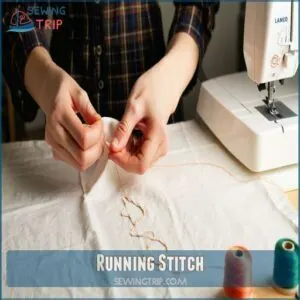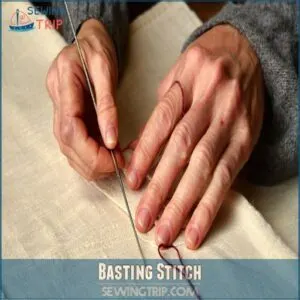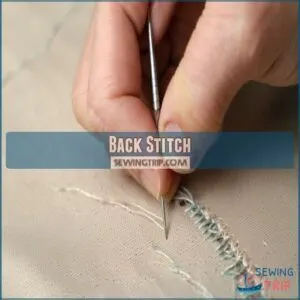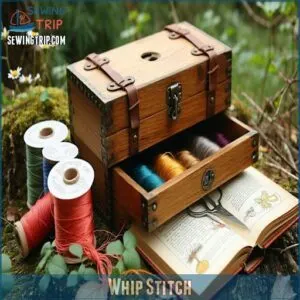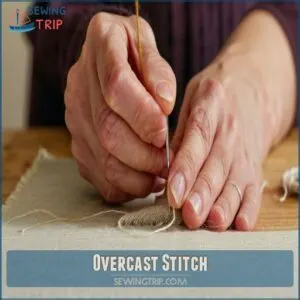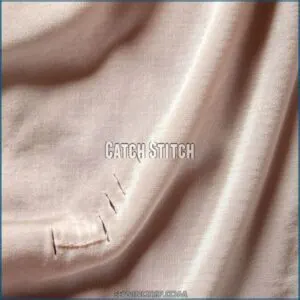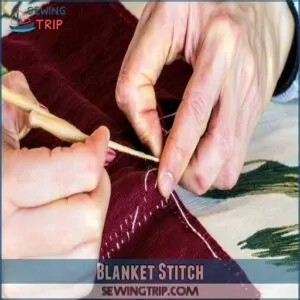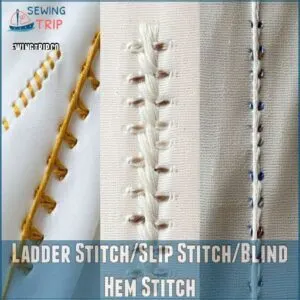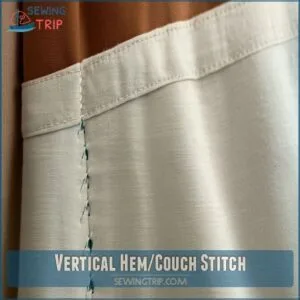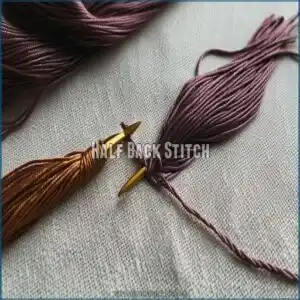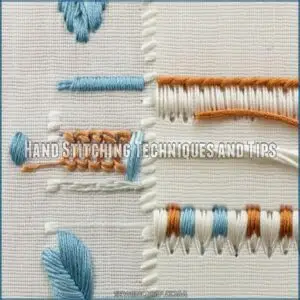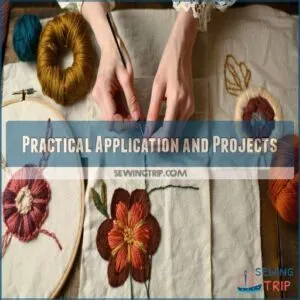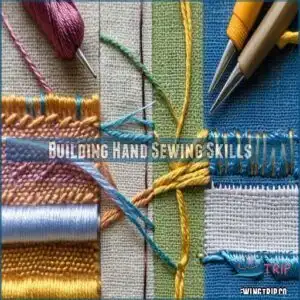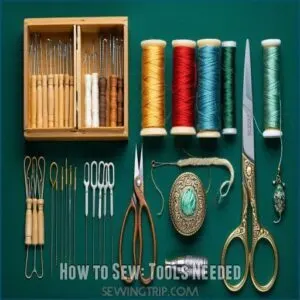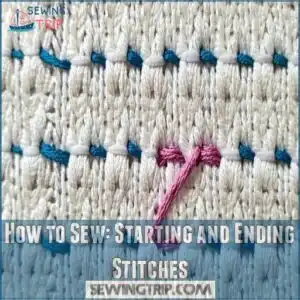This site is supported by our readers. We may earn a commission, at no cost to you, if you purchase through links.
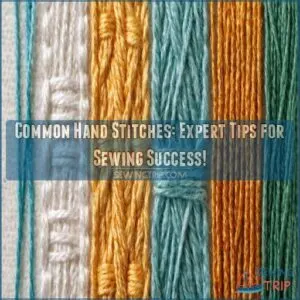 Common hand stitches and their uses are essential for sewing projects.
Common hand stitches and their uses are essential for sewing projects.
The running stitch is your go-to for basting, quilting, or gathering fabric quickly.
The backstitch works wonders for strong, durable seams—think of it as the backbone of sewing.
Need to hem or join edges? The whip stitch and overcast stitch handle both neatly, while the catch stitch secures stretchy hems invisibly.
For mending torn seams or creating invisible hems, the ladder stitch is a lifesaver.
And decorative finishes? That’s where the blanket stitch shines.
Mastering these versatile stitches is like having a sewing toolbox in your back pocket—practical and reliable!
Table Of Contents
- Key Takeaways
- Essential Tools and Needle Selection
- Basic Stitches for Various Purposes
- Hand Stitching Techniques and Tips
- Practical Application and Projects
- Building Hand Sewing Skills
- How to Sew: Tools Needed
- The Most Common Basic Hand Stitches
- How to Sew: Starting and Ending Stitches
- Frequently Asked Questions (FAQs)
- Conclusion
Key Takeaways
- You’ll master essentials like the running stitch for quick fixes, the backstitch for strong seams, and the whip stitch for clean edges.
- Decorative hand stitches like the blanket and ladder stitch let you add flair while delivering professional finishes.
- Picking the right needle, thread, and stitch ensures precision and durability across projects from mending to crafting.
- Starting small with basic stitches builds confidence to tackle bigger, more creative sewing challenges.
Essential Tools and Needle Selection
In the world of hand sewing, choosing your needles and tools carefully is key, as they’re the unsung heroes of your crafting success.
From fine embroidery needles to sturdy all-purpose threads, having the right equipment will transform your sewing projects from frustrating to fantastic.
Needle Types
Every stitch starts with the right needle – your secret weapon in the sewing world. Choosing the perfect needle can transform your hand-sewing experience from frustrating to fabulous.
For instance, selecting a needle with the right size, such as consulting a needle size guide, is key.
Here’s how to nail your needle selection:
- Sharps: The Swiss Army knife of needles
- Match needle size to fabric weight
- Understand point types for different materials
- Consider eye size for thread compatibility
- Specialized needles for unique sewing needs
Mastering these tips will have you stitching like a pro in no time.
Thread Selection
Choosing the right thread is like picking the perfect dance partner for your fabric.
After nailing down your needle selection, you’ll want to match your thread to your project’s unique personality.
Here’s your thread selection cheat sheet:
- Cotton Threads: Breathable, perfect for natural fabrics
- Polyester Threads: Durable, great for synthetic materials
- Silk Threads: Luxurious, ideal for delicate projects
- Embroidery Threads: Vibrant, adds decorative flair
- Specialty Threads: Metallic, variegated, or textured options
Color matters too! Blend seamlessly or create bold contrast.
Pro tip: Test your thread’s strength by gently pulling—it should resist without snapping.
Your thread choice can make or break your hand stitching adventure, so choose wisely and sew confidently.
Needle Threader
Struggling with threading needles? A needle threader transforms this tiny frustration into a quick win for sewists.
Whether you’re working with delicate embroidery threads or thick upholstery materials, these handy tools slide wire loops through needle eyes with precision.
From manual wire designs to automatic mechanisms, needle threaders streamline your sewing setup, saving time and reducing eye strain.
They’re an essential companion in any hand stitches toolkit.
Basic Stitches for Various Purposes
Whether you’re mending a favorite shirt or creating a handmade masterpiece, mastering basic hand stitches is your ticket to sewing success.
You’ll discover ten essential stitches that’ll transform your projects from amateur to professional, giving you the confidence to tackle any fabric challenge.
Running Stitch
Glide your needle through fabric with the running stitch, a classic hand sewing technique that speaks volumes in simplicity.
This versatile method weaves magic across various projects:
- Quilting intricate patterns
- Basting delicate garment seams
- Creating temporary fabric holds
Master the running stitch variations, adjusting stitch length and tension to suit different fabric types and sewing needs.
Basting Stitch
After mastering the running stitch, you’ll find the basting stitch your new secret weapon in sewing precision. This temporary stitching technique holds fabric pieces together before permanent seaming, giving you room to adjust and perfect your project. Think of it as a fabric roadmap that guides your final creation.
| Basting Type | Best Used For |
|---|---|
| Machine Basting | Quick, long seam preparations |
| Hand Basting | Delicate fabrics, pattern fitting |
| Pin Basting | Quilting, precise fabric alignment |
Basting makes complex sewing projects feel like a breeze, letting you preview and tweak designs before committing to final stitches. Basting is a temporary stitching technique. This is useful for sewing precision and complex sewing projects.
Back Stitch
Mastering the backstitch transforms your hand sewing from amateur to artisan. This powerhouse stitch creates rock-solid seams that laugh in the face of wear and tear. Ready to level up your sewing game?
- Unbeatable strength for high-stress fabric areas
- Perfect for reinforcing seams and patches
- Versatile across multiple fabric types
- Easy to learn with minimal practice
Backstitch variations like whipped and split techniques offer creative flexibility.
Whether you’re mending a favorite jacket or crafting a handmade treasure, this stitch helps your work stand the test of time.
Whip Stitch
Every crafty sewist knows the whip stitch is a superhero of hand sewing techniques.
You’ll love how this versatile stitch smoothly connects fabric edges with diagonal, overlapping movements.
Perfect for hemming delicate materials or joining pieces in craft projects, whip stitch works magic on various fabric types.
By adjusting your thread tension and stitch angle, you can create everything from nearly invisible seams to decorative borders.
It’s a game-changer for mending and creative sewing adventures. hand sewing techniques
Overcast Stitch
When diving into hand stitches, the overcast stitch emerges as a versatile technique for crafting enthusiasts.
This stitch goes beyond basic seam finishing, offering multiple applications in your sewing projects:
- Prevents fabric edges from unraveling
- Adds durability to delicate materials
- Creates clean, professional-looking edges
- Works brilliantly on various fabric types
Master your stitch tension to transform this simple technique into a powerful tool for securing seams and elevating your hand sewing skills. This makes it a versatile technique for crafting enthusiasts.
Catch Stitch
Master the catch stitch, your secret weapon for creating flexible, nearly invisible hems that dance with your fabric’s movement. This chameleon of hand stitches glides across knits and stretchy materials, keeping seams smooth and professional.
To achieve the perfect catch stitch, choose the right needle size for fabric weight.
You’ll love how it:
- Preserves fabric elasticity without creating tension
- Conquers curved edges with remarkable ease
- Hides stitching like a sewing ninja
- Elevates garment finishing to couture-level precision
Unleash your inner fashion maestro with this versatile stitch technique.
Blanket Stitch
After conquering the catch stitch, you’ll find the blanket stitch equally empowering. This versatile hand sewing technique transforms fabric edges with decorative flair.
Ideal for preventing fraying and adding visual interest, blanket stitch variations let you customize your projects.
You’ll create neat, uniform edges that look professional with practice.
Whether you’re working on quilts, appliqués, or clothing details, understanding stitch tension and fabric choices makes all the difference.
Pro tip: Keep your stitches evenly spaced for a polished finish that’ll make your handiwork shine.
Ladder Stitch/Slip Stitch/Blind Hem Stitch
From blanket stitches to invisible magic, the ladder stitch becomes your secret weapon in sewing.
This slip stitch lets you create seamless, nearly invisible hand stitches that transform your projects.
Perfect for hemming delicate fabrics, the ladder stitch (or blind hem stitch) slides between fabric layers, leaving no trace. These stitch variations give your hand-sewn items that professional, polished look every crafter dreams about. Ladder stitch is a secret weapon.
Vertical Hem/Couch Stitch
Want to add a pro touch to your sewing? The vertical hem or couch stitch is your secret weapon.
This versatile technique lets you create invisible hems and decorative accents with ease.
By carefully securing threads along fabric edges, you’ll master one of the most elegant hand stitches in your sewing arsenal.
Perfect for giving garments that couture-level finish.
Half Back Stitch
Master the half back stitch, a versatile technique used in 2 out of 5 couture garments.
This stitch blends strength and elegance, perfect for lightweight to medium fabrics.
Experiment with different half back stitch variations to add texture and durability to your projects.
Adjust stitch tension carefully—too tight can pucker fabric, too loose weakens the seam.
Whether you’re mending a delicate blouse or creating intricate embellishments, this sewing technique offers precision and creative freedom for beginners and seasoned crafters alike.
Hand Stitching Techniques and Tips
Hand stitching isn’t just a skill—it’s a crafty superpower that’ll transform your sewing projects from basic to brilliant.
You’ll discover simple techniques that’ll help you create professional-looking finishes.
You’ll repair garments with ease.
And you’ll gain mastery over a world of creative possibilities right at your fingertips.
All-Purpose Polyester Thread
Polyester thread quickly becomes a sewer’s best friend, offering unmatched durability for countless projects.
Its resilient fibers resist stretching and shrinking, making it ideal for everything from delicate repairs to robust garment construction.
Available in a rainbow of colors, this versatile thread seamlessly blends strength with flexibility, ensuring your hand stitches look professional and last longer than traditional alternatives. Polyester thread is a best friend.
Embroidery Stitches
Since ancient times, embroidery has transformed simple fabrics into stunning canvases of artistic expression. Your hand embroidery journey begins with mastering diverse stitch variations that breathe life into every project.
To further enhance your skills, familiarize yourself with an embroidery stitch guide embroidery stitch resources that outlines various techniques and patterns.
- Explore classic hand embroidery stitches like satin, chain, and French knots to create textural landscapes.
- Experiment with thread choices that blend colors seamlessly, turning ordinary fabric into extraordinary artwork.
- Practice beginner-friendly embroidery stitch patterns that gradually build your confidence and creative skills.
Unlock your inner artist, one thread at a time.
Button Sewing
Sewing buttons may seem simple, but it’s all about getting the details right. Match your thread choice to the fabric and verify that your button size suits the garment.
For movement, build a button shank by wrapping thread around the stitches underneath.
Use a buttonhole stitch to reinforce edges on hand-sewn holes.
Securing buttons doesn’t take long, but strong, neat hand stitches can transform repairs or projects into durable, polished pieces.
Sequin Sewing
Adding a dash of sparkle is easy with proper sequin placement and the right tools.
Use a fine, sharp needle to handle delicate sequins and facilitate smooth attachment.
Whether you’re crafting decorative hand stitches for bold patterns or subtle accents, sequin density depends on the look you’re after. Try sewing stitches like a straight stitch or backstitch to secure each piece.
Sequins come in endless types, so play around with styles to create unique designs.
A little shimmer goes a long way in transforming any project.
Gathering Fabric
Gathering fabric adds flair to sewing projects like skirts or ruffled tops—and it’s easier than you think. Here’s how to nail it:
- Use lightweight fabric types for more manageable gathers.
- Sew two parallel running stitches, leaving long thread tails.
- Pull thread gently to control tension and create even decorative gathers.
- Distribute folds by hand for desired stitch density.
Mastering gathering techniques makes any project pop with handmade charm!
Starting and Ending Stitches
Beginning and ending stitches set the stage for confident sewing.
Guarantee neat finishes by anchoring your thread with small, discreet knots. For delicate fabric, keep knots firm but subtle; for sturdy seams, a bit stronger.
Use even thread tension, trimming extra threads snugly to the fabric. Bury thread tails between layers for invisible ends—it’s like your secret sewing magic!
| Task | Technique | Result |
|---|---|---|
| Securing threads | Small knots | Neat finishes |
| Adjusting knots | Varying firmness | Thread stability |
| Concealing ends | Bury thread tails | Invisible results |
Unpicking Mistakes
Fixing errors in hand sewing doesn’t have to feel overwhelming.
Unpicking mistakes is straightforward with the right unpicking techniques. Use a seam ripper—its pointed tip slides under sewing stitches for beginners and pros alike. Gently break the thread without tugging the fabric.
To prevent errors next time, stitch slowly and review as you go. Patience and care make sewing repairs stress-free.
Practical Application and Projects
You can put your hand sewing skills to good use with practical projects like creating felt pin cushions, fabric flowers, or even scrunchies.
Whether you’re mending clothes, tackling crafts, or starting small projects, it’s a fun way to practice and make something useful.
Felt Pin Cushion Project
Feeling inspired by hand stitching techniques? Try creating a felt pin cushion—it’s a fun, functional project that showcases your skills.
Start by cutting felt shapes, like circles, squares, or playful designs (think hearts or stars). Felt is ideal for this because it doesn’t fray and holds stitches beautifully.
Choose a needle that matches your thread weight, and consider using embroidery floss for decorative stitches like blanket or chain stitches to add flair. Embroidery floss and decorative stitches are great options.
For filling options, opt for polyfill, fabric scraps, or even rice for a weighted feel.
Once stuffed, bring it all together with neat running or ladder stitches. Add finishing touches with embellishments, like small beads or buttons, to create a unique design. Finishing touches make it special.
Whether you’re following a sewing stitches guide or winging it, this project is perfect for mastering basic hand stitches while making your sewing setup stylish and practical. This felt pin cushion is a fun project.
Small Projects (Fabric Flowers, Purses, Scrunchies)
Creating fabric flowers, purses, and scrunchies is a fun way to show off your skills.
Start with easy hand stitches like the running stitch or whip stitch, and plan each project carefully by choosing fabrics that match their purpose.
Add embellishments—think buttons or beads—for a personal touch.
Whether you’re upcycling old fabrics or experimenting with new ones, these sewing projects allow you to explore stitch selection, creativity, and finishing touches confidently.
For inspiration and guidance, explore beginner sewing projects and perfect your skills with simple and useful projects like drawstring gift bags or fabric koozies beginner sewing projects.
Clothing Alterations and Repairs
Hand sewing is a lifesaver for clothing alterations and repairs, offering the precision machines often can’t deliver.
Whether you’re tackling a hem repair, patching holes, or sewing on a button, hand stitches give you full control.
Seam ripping and adjusting a garment’s fit? No problem. Need to replace a zipper or fix stubborn seams? Hand stitching guarantees professional results.
Master a few basic sewing stitches, and you’ll seamlessly restore garments, saving money and extending your wardrobe’s life effortlessly. Hand sewing is a lifesaver for clothing alterations.
Craft Projects
Whether you’re fixing a tear or designing felt ornaments, hand sewing opens endless possibilities for craft projects.
Mastering the basic stitches, such as the basting stitch guide, can help you get started.
Blanket stitches add charm to fabric edges, ladder stitches discreetly join pieces, and half-back stitches create bold, decorative patterns.
Experiment with stitch patterns to bring project ideas to life—like vibrant patchwork or fun embellishments for cushions.
Thoughtful fabric choices and finishing touches elevate your work. With a sewing stitch guide, you’ll master different hand sewing technique projects in no time.
Building Hand Sewing Skills
You don’t need fancy equipment or formal lessons to start building your hand sewing skills.
With patience and a simple sewing kit, you can work your way up from basic stitches to more advanced techniques.
Learning in The Absence of Guidance
Starting out without guidance? You’re not alone. Many learn independently with self-teaching resources and online tutorials.
Break it down:
- Start small—focus on hand sewing stitches like running or whip stitch.
- Use a sewing stitch guide for consistency.
- Practice projects to overcome challenges and discover types of hand stitches.
Remember, common hand stitches build all kinds of confidence!
Progression to Sewing Machines
Mastered hand stitches? It’s time to explore sewing machines. Beyond sewing basics, enjoy faster stitching and precise patterns as you discover advanced techniques.
Don’t worry—your hand sewing foundation makes this move smooth. Practice machine vs. hand methods to discover what suits each project best. Keep in mind that choosing the right method is key to your project’s success.
| Hand Sewing | Sewing Machines |
|---|---|
| Portable and quiet | Fast and efficient |
| Great for small repairs | Perfect for big projects |
| Requires patience | Requires setup time |
| Endless creativity hand | Precise stitch variety |
Foundation for Beginners
Learning hand sewing is like planting seeds that grow into creative mastery.
Start with basic tools—thread, scissors, and needles. Choosing needles depends on your fabric: finer needles for delicate fabrics, thicker ones for sturdy materials. Get familiar with thread types and pair them wisely.
Practice basic hand stitches like the running stitch and backstitch to build confidence.
Simple projects, like hemming or creating fabric flowers, are perfect for beginners. Follow a stitch guide for beginners, and soon your stitch practice will bloom into satisfying creations.
Sewing Kit Preparation
You’re ready to gear up for sewing success, so let’s talk about your sewing kit. A good setup means you’ll always have the right tools for your sewing projects.
Here’s what you need:
- Needles and Thread: Grab a range of needle types and all-purpose polyester thread for versatility in repairs and projects.
- Cutting Tools: Invest in small, sharp scissors for precision cutting and trimming.
- Storage Solutions: Use a compact box or case to keep your sewing supplies organized and easy to grab.
With these essentials, you’re set for creative stitching!
How to Sew: Tools Needed
Starting your hand sewing journey means first grabbing the right tools. Think of it like packing for a trip—what you bring sets you up for smooth sailing.
Choosing the best sewing needles for your specific project is key, and you can find a variety of them at best sewing needles.
- Needles: Different projects call for different needle types. Sharps work for general use, leather needles pierce tough fabrics, and embroidery needles give you room for thicker threads. Choose wisely, and your stitches will thank you.
- Thread Choices: All-purpose polyester thread is your go-to, it’s strong, versatile, and holds up like a champ. Match the thread color to your fabric for a polished finish.
- Other Sewing Supplies: A good pair of sharp scissors prevents fraying, a thimble protects your fingers when working with thick fabric, and a needle threader can save your sanity (especially when working with tiny needles).
With these essentials in hand, you’re ready to create magic with stitches!
The Most Common Basic Hand Stitches
Hand stitching isn’t just sewing—it’s crafting. With the right stitches and a bit of practice, you can repair, create, and embellish fabric with precision. Whether you’re hemming jeans or adding flair to a craft, knowing the basics gives you freedom for all kinds of projects.
Maintaining consistent stitch length is also essential, and practicing on scrap fabric will help you develop this skill, learning about thread tension techniques.
Here’s a quick breakdown of popular stitches:
| Stitch | Why You’ll Love It |
|---|---|
| Running | Quick and easy for straight seams. |
| Basting | Perfect for temporary holds. |
| Back | Strong, neat seams for heavy fabrics. |
| Whip | Secures edges with visible stitching. |
| Ladder | Creates nearly invisible hems. |
Got a fabric in mind? Consider the stitch’s purpose. A running stitch works for quick fixes, while the back stitch handles stress like a champ. Using the right tension control avoids uneven stitches—critical for stretchy or delicate fabric types.
Don’t forget: choosing the right needle size and thread can make or break your sewing stitches. Have fun experimenting with stitch variations in your next project. These basic hand stitches empower both beginners and seasoned crafters to tackle ambitious ideas!
How to Sew: Starting and Ending Stitches
Getting your sewing stitches to look polished and stay secure is all about mastering the start and finish. Whether you’re tackling basic hand stitches or detailed embroidery, these techniques guarantee neat finishes and prevent unraveling. For an alternative to knotting, you can try the waste knot method, which keeps the front of your work neat and tidy.
- Secure Thread Ends: Start strong by tying a stable knot at the end of your thread. For extra durability, loop the thread 2-3 times before pulling tight. Avoid starting too close to the fabric’s edge—leave about 1 cm to prevent fraying.
- Knotting Techniques for Stability: For trickier fabrics such as leather, an awl may come in handy to pull your knot through the backside. If you’re sewing decorative or fine embroidery stitches, start with a small, faint knot and trim close for a neat appearance.
- Reinforce Your Stitches: As you finish, make a small loop with the thread and pull the needle through to lock it. For thicker fabrics or high-stress areas, repeat 2-3 times.
- Neat Finishes: To hide thread ends, weave them under nearby stitches a few times before trimming. With clean sewing stitches, your hand-sewn works will shine like they came off a machine—minus the machine!
Frequently Asked Questions (FAQs)
What are the most important hand stitches for hand sewing?
Think of sewing as your toolkit.
mastering the running stitch, backstitch, slip stitch, blanket stitch, and whipstitch gives you all the essentials.
These stitches let you mend, create, and add flair to practically anything.
What are the different types of hand sewing stitches?
Hand sewing stitches include the running stitch, backstitch, slip stitch, blanket stitch, whip stitch, chain stitch, cross-stitch, darning stitch, overcast stitch, pad stitch, and buttonhole stitch.
Each serving unique purposes in sewing, mending, or decorating.
What is hand stitching & why is it important?
You’ve probably heard that hand stitching is a dying art, but its importance is still very much alive.
It’s a skill that offers precision, control, and a sense of accomplishment, making it a valuable asset.
What are the different types of stitches?
Stitches like running, backstitch, slip, whip, blanket, and buttonhole each serve unique purposes.
Whether you’re mending, decorating, or constructing, these techniques guarantee strong seams, neat finishes, and creative designs in your sewing projects.
Are hand stitches still used today?
In sewing, old habits die hard.
Hand stitches are still key for delicate fabrics, repairs, intricate designs, or tight spaces machines can’t handle.
They’re timeless and versatile, blending practicality with creativity.
Why do you need stitches?
You need stitches to hold fabric pieces together, repair tears, or create decorative patterns.
They’re essential for fixing clothes, finishing edges, or crafting unique designs.
Hand sewing adds precision and a personal touch.
What is the most used hand stitch?
The running stitch takes the crown as the most-used hand stitch.
It’s quick, versatile, and perfect for basics like hemming, gathering, or mending.
Think of it as your sewing toolbox MVP – always handy!
What are the three basic hand stitches?
Running stitch, backstitch, and slip stitch are the three basics.
Running stitch simplifies repairs, backstitch strengthens seams, and slip stitch stays hidden while hemming or finishing.
Master these, and you’ve nailed hand sewing essentials.
What is used for hand stitching?
Picture sewing as storytelling—your needle and thread are the main characters.
You’ll need fabric, scissors, needles, thread, and maybe a thimble.
Add patience and practice, and you’ve got everything for hand stitching success.
What are different stitches used for?
Different stitches serve unique purposes: backstitch creates durable seams, slip stitch hides joins, blanket stitch prevents fraying, and running stitch works for gathering or basting.
Each stitch fits tasks like mending, tailoring, or decorating.
Conclusion
Learning these common hand stitches and their uses doesn’t have to feel overwhelming.
Once you’ve got the hang of running, back, whip, and ladder stitches, you’ll see how they open up endless project possibilities—from quick fixes to creative crafts.
Start with small projects, like hemming or mending, and gradually take on more complex designs.
Remember, practice builds, so don’t stress about perfect stitches right away. Just grab your needle, thread, and get started on sewing success.
- https://www.mollyandmama.com.au/how-to-back-stitch-practical-tips-for-hand-embroidery/
- https://docs.wilcom.com/embroiderystudio/e4/en/MainHelp/Chenille/chenille_basics/Stitch_length.htm
- https://xstitchmag.com/history-of-cross-stitch/
- https://northshorecrafts.com/hand-sewing-stitches-and-their-uses/
- https://mindymakes.com/hand-sewing-stitches/


